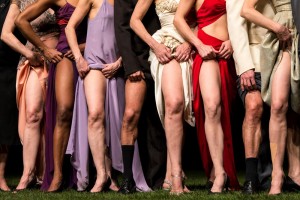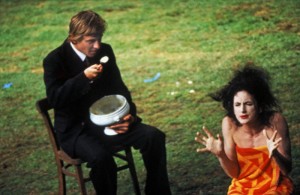We all grow older. Since Performance Monkey last tottered towards the keyboard, his paws have grown sclerotic, his plush has rubbed off, he displays the rusty effect of winter and rough weather. He’s nearer death, as are we all.
These merry reflections are inspired by Pina Bausch’s 1980, performed by the sublime Tanztheater Wuppertal. This was the work that turned a whole generation of British theatregoers into Pinaholics when it first visited London, nearly new, in 1982. It was the tanztheater gateway drug that blew the minds of its audience and, judging by the sold out theatre for the show’s return, 32 years on, has jacked synapses and blissfully polluted imaginations all over again.
Equally mind blowing is the fact that four of the original dancers are still in the cast. Previous generations of actors might stick to a celebrated role throughout their career (34 years also separated David Garrick’s first and last Hamlet), but it’s rare for dancers to achieve such a span. Margot Fonteyn and Rudolf Nureyev, defying the limitations of their charismatic bodies, were exceptions. Unless body and spirit (or financial desperation and sheer refusal to acknowledge time) intervene, most dancers will politely leave the stage around 40.
The Wuppertal troupe don’t only defy time – they embrace it. Did Bausch realise how much her works would accrue meaning as her dancers aged? In 1980 – a work about grief and loss and childhood and play – there’s a profound delight to watching performers deep in middle age behaving simultaneously like crones and toddlers. I touched on this in a short Sunday Times review, but the impression has sharpened since my first viewing last week (I went back for a second helping this weekend. Of course I did).
The original cast still gleam on YouTube. A new generation fills most roles, shimmies into the signature evening gowns (they remind us that the texture of confessional improvisation is carefully constructed – these are roles, not therapy outtakes). But it’s still a shock to see the younger Mechthild Grossman like a palimpsest over her magnetic present performance – her husky voice now dropping like a lift in freefall, her roguish disenchantment thoroughly embedded. Or Lutz Förster, the company’s newly appointed artistic director, who was tall and elegant and is now tall, elegant and slightly cadaverous. He leads by example, stripping naked and waggling his feet like an infant, his flesh as vulnerable as ever, but with the vulnerability of age.
Most of the dancers are younger, newer, but in Wuppertal these are relative terms. Even the newest recruits seem to have old souls, while the company’s veterans grow more delightedly childish by the year.
Why does this matter? Because the decade-deep work of time is something that performance rarely captures. We see Leontes in The Winter’s Tale as a fretful husk 16 years after his titanic jealousy pulled down his marriage and his sanity. Förster’s sardonic tribute to a wooden chair recalls The Cherry Orchard, where Mme Ranyevskaya returns to the nursery of her childhood home, and we see that she has never truly left. But Bausch’s dancers suggest the children and adults they were, are and will be. Our bodies may be frailly adult. Our problems may be grindingly grown up. Our spirits may still skew young and foolish – and like the figures in 1980, we may still not know how to say goodbye.
See photos of the current cast (including the dancers showing some leg, top) by Foteini Christofilopoulou for Dance Tabs
Follow David on Twitter: @mrdavidjays



This is spot on.
A suggestion that Pina Bausch developed an interest in the extra dimension brought to her works by the age of her dances can be found in her restaging of Kontakthof with retired amateur dancers (I saw this in Hannover in 2000 but I suspect it toured). There were sections in that piece in which the dancers presented themselves to the audience which somehow carried the ghosts of the original production’s younger cast. It was profoundly moving and of course startlingly unusual.
Absolutely, James. I have seen Kontakthof with its cast of over-65s a couple of times – and on its last visit to London (in 2010), it was paired with a bersion performed by a teenage cast. i wish I’d seen both, for exactly that sense of ghosts of what the dancers were or would become…
I’m so out of the loop!
Nonsense. You’re just very, very selective.